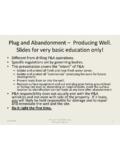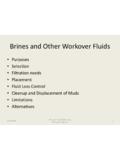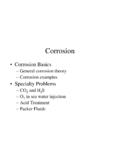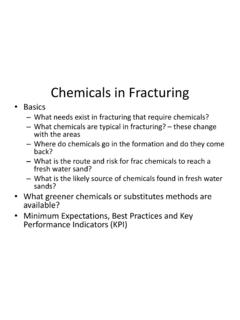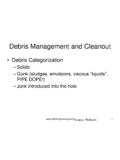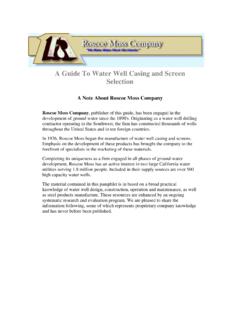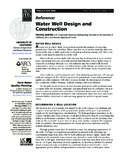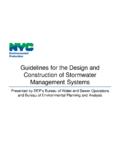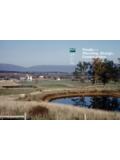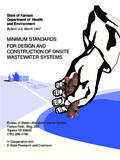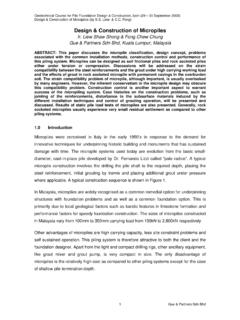Transcription of Well Construction - gekengineering.com
1 well Construction Basics How Wells are Designed & Constructed Minimum Expectations and Best Practices Assessing Completion Reliability and Risk Key Performance Indicators Tubular Design and Downhole Equipment Casing is run to: prevent fill (formation fragments) from entering the wellbore protect fresh water zones from other fluids isolate zones - prevent or channel flow make drilling possible: mud weight has to stay in the window between a minimum that will control the pore pressure (and formation heaving) and a maximum that will not fracture the formation. Casing is also sometimes used where it is not needed. Tubular String- 8 Design Factors Tension tube must stand its own weight in the running environment.
2 Tubing must stand additional loads when pulling out or setting packers and forces due to temperature and pressure changes. Burst maintain integrity with high internal tubing pressures with little or no annular pressure support. Collapse - maintain integrity with high annulus pressures with little or no internal pressure support. Compression tube must stand compressive loads when setting some packers and in highly deviated wells or dog legs. Tubular String- 8 Design Factors Couplings free from leaks, maintain ID clearance, strength through bend areas and in compression and tension loads. Corrosion - tube must be designed to counter corrosion reactions with flowing fluids over its lifetime. CO2, H2S, acid, cracking, etc.
3 Abrasion/Erosion equipment must withstand abrasion and erosion loads over lifetime Stimulation Loads The tubular must withstand loads from acids, fracturing or other stimulations Pp = psi/ft Pf = psi/ft Pp = psi/ft Pf = psi/ft Pp = psi/ft Pf = psi/ft Pf = Pf = Pf = shale shale surface Pp = psi/ft Pf = psi/ft Pp = psi/ft Pf = psi/ft Pp = psi/ft Pf = psi/ft Pf = Pf = Pf = shale shale surface ? Pp = psi/ft Pf = psi/ft Pp = psi/ft Pf = psi/ft Pp = psi/ft Pf = psi/ft Pf = Pf = Pf = shale shale surface Pp = psi/ft Pf = psi/ft Pp = psi/ft Pf = psi/ft Pp = psi/ft Pf = psi/ft Pf = Pf = Pf = shale shale surface Since the conductor is often short and rarely cemented, it is not usually regarded as a pressure seal.
4 Baku Suggest driving the 28 conductor into place. Drilling in may disturb sediments and aggravate sediment sides??? After the conductor is set, the bore hole is drilled to below the deepest fresh water source. The next smaller casing is run to bottom (maintaining minimum clearances), and this string is cemented. The BOP is commonly mounted on this string. Baku - Surface or protection string 20 , usually drilled, but may be driven. One or more production strings or liners are common for a well , depending on mud weight window and things like pipe sticking, reactive shales, and other problem areas. Baku Protection string - 13-3/8 drilling wear can be a problem how to repair? Production string - 9-5/8 , run to surface, but only partially cemented.
5 Critical points on liners are the seal at the top and cementing quality along the length. Simple gas well wellhead, showing two master valves, a wing valve (leading to a choke unit) and a swab or lubricator access at the top. This is one type of a well head flange. This unit slips on the top of the casing string and is welded to give a seal. The port in the side gives access to the annular area when tubing is run and hung off in the bowl in the top, inner part. The top is a flange with a seal groove that bolts to the wellhead or spool above. This is a very simple schematic - usually multiple casing strings and tubing are included in most cases, there are a minimum of two barriers unless leak potential is very low or there is no potential damage.
6 Is every string cemented back to surface? No most times, it cannot be done in one operation. Casing Design Intent A annulus - tubing will collapse before casing bursts. B annulus production casing will collapse before surface casing will burst. C annulus usually cemented up, but watch any sealed area. well Design: Liner Casing Casing Pipe Details and Considerations: press during production. pressure during shut-in. pressure during frac. fluid density & height. in well use? Gas lift source in the A annulus instead of packer fluid? of leaks pressure at start-up and flow area below the tubing 2. A annulus tubing/production liner/production casing 3. B annulus production casing/surface casing annulus 4.
7 C annulus surface casing/conductor a. max production pressure b. max shut-in pressure c. max frac pressure 2. A annulus tubing/production liner/production casing a. initial design pkr fluid & no surf. press. b. start-up temp swing effect on press c. change in use to gas lift supply path? d. leak? 3. B annulus prod csg/surf. csg annulus a. initial design fluid packed annular press b. leak from high pressure A and add temp: 1. fluid packed 2. gas over fluid 4. C annulus surface casing/conductor a. cemented up or ? b. leak? Special Case: How does changing the A annulus from brine to 2000 psi gas lift supply? Reduces the pressure at the shoe (removal of most of the hydrostatic column) Backs up (increases) the collapse resistance of the production casing in the B annulus.
8 Must consider the effect of liquid packed vs. gas cushion. Tubing: burst and collapse set by production, stimulation and kill forces. A annulus select to collapse the tubing before production casing will burst. Factors: 1. Liner top integrity 2. Is the shoe designed to leak? 3. What back-up force is provided by the tubing? 4. What back-up force is provided by the cement? Casing collapse in a deep water environment occurred while running a 7 string at about 7500 of water. The automatic fill float valve failed and much of the string was only air filled when the pipe began to collapse. 17 joints collapsed in one run of the collapse across couplings! Casing Grades API Grade Minimum Yield H-40 40,000 J-55 55,000 K-55 55,000 C-75 75,000 N-80 80,000 L-80 80,000 C-95 95,000 P-110 110,000 Q-125 125,000 V-150 150,000 ConnectionsCollapseWearBrittleunknown199 0' ModeTimePeriodCasing Field Failure History1990's1980'sSource Brian Schwind - PPI Monobore: mixed grades, same weight Mixed grades and weights Mixed weights, same grade Casing Design Options think about running and setting packers.
9 Tubular Joints T&C Threaded and Coupled LT&C Long Thread and Coupled ST&C Short Thread and Coupled Integral direct connection using thread cut onto one pipe and a box and thread cut into another. Pin Pin Coupling or Connection Pin Box Integral Connector Threaded and Coupled EU or external upset strong connection, full opening, clearance problems IU or internal upset moderately strong connection, reduced opening, good external clearance NU or non-upset weak connection, full opening, good external clearance Spotting Problems With Connections. What does it take? 1. Initial Thread Inspections 2. Torque/turn indicator and 3. Leak testing effective? BP 5-1/2" 20# De ltasR2 = TorqueDelta Turn?
10 Why Cement? Completes the isolation step that was started with casing. Pressure isolation Pipe support and protection Exterior corrosion Pressure control Load and force application support Leakoff control prevents crossflow? Water influx control Statistics Primary cementing cost about 5% of well cost. About 15% of primary cement jobs require squeezing Total cost of cementing when squeezing is required is about 17% of well cost. Typical number of squeezes required to fix a problem in a primary cement job = 3. Cement Circulation Path: Down the casing and up the annulus Concerns: Cement density vs. pressure window from formation Cement bond between pipe and formation Cement pump time Ability to place the cement over the whole column (fluid loss control, correct volumes, pumpability) Cement strength development The quality and longevity of the seal.
